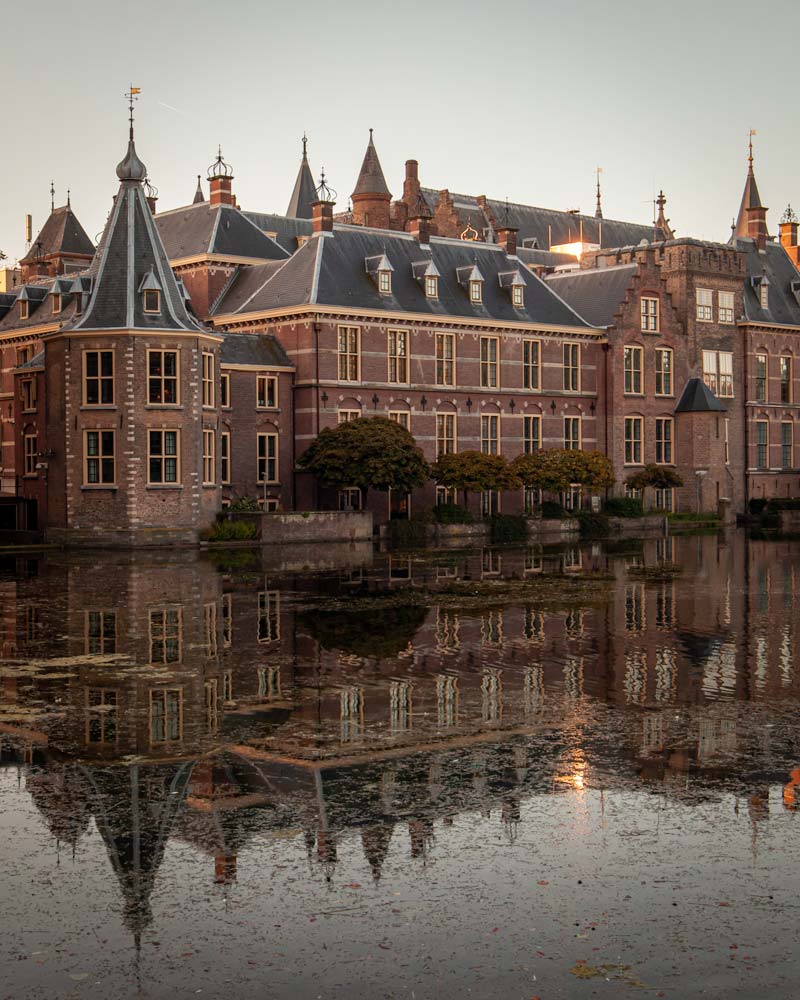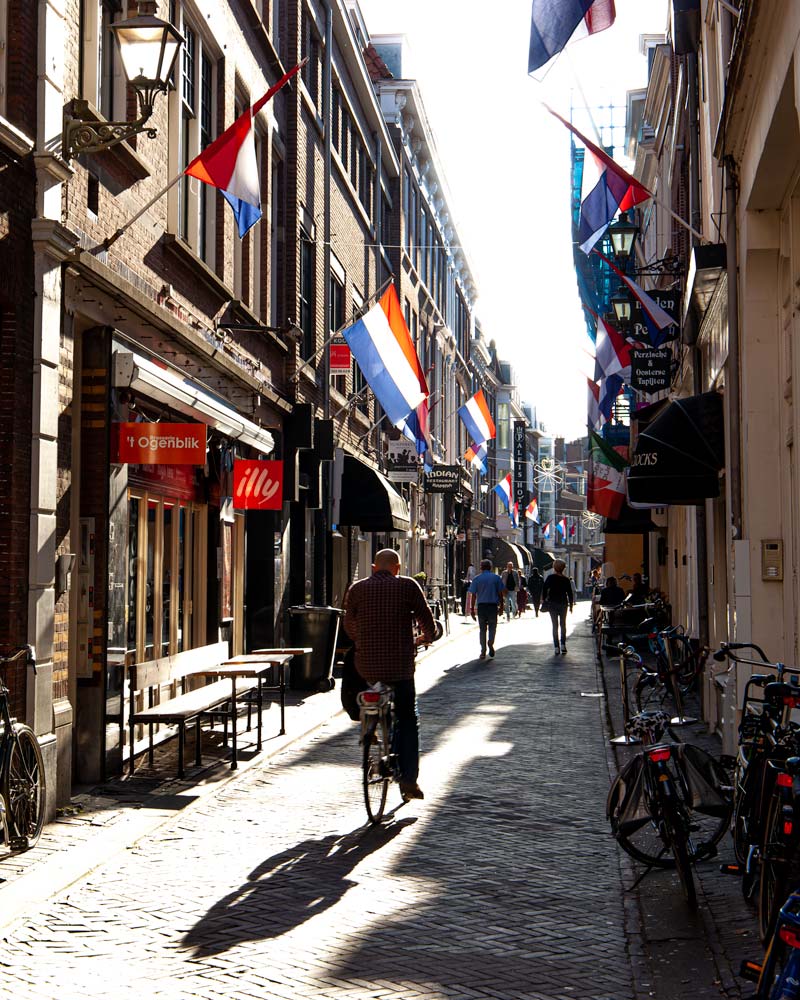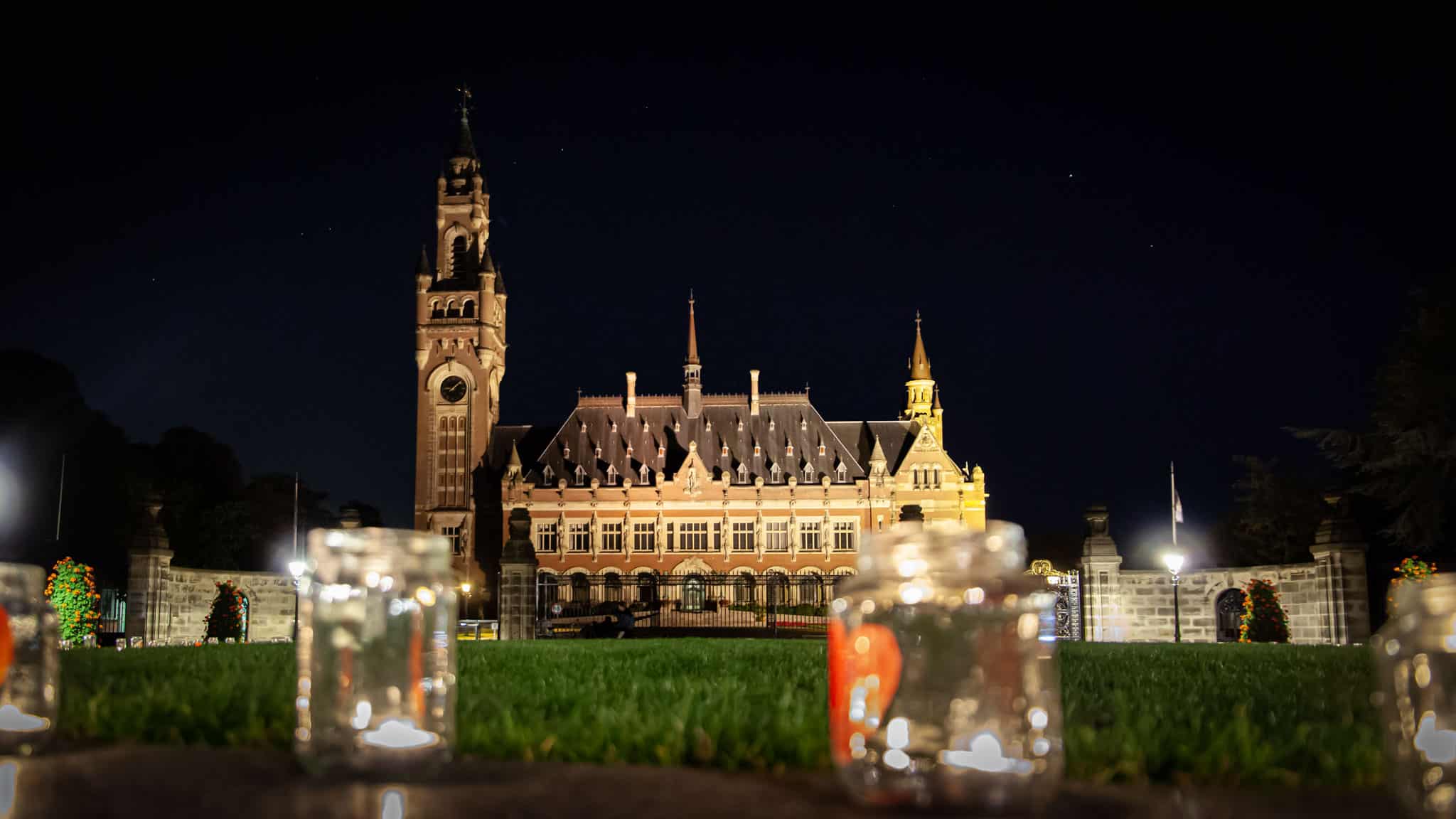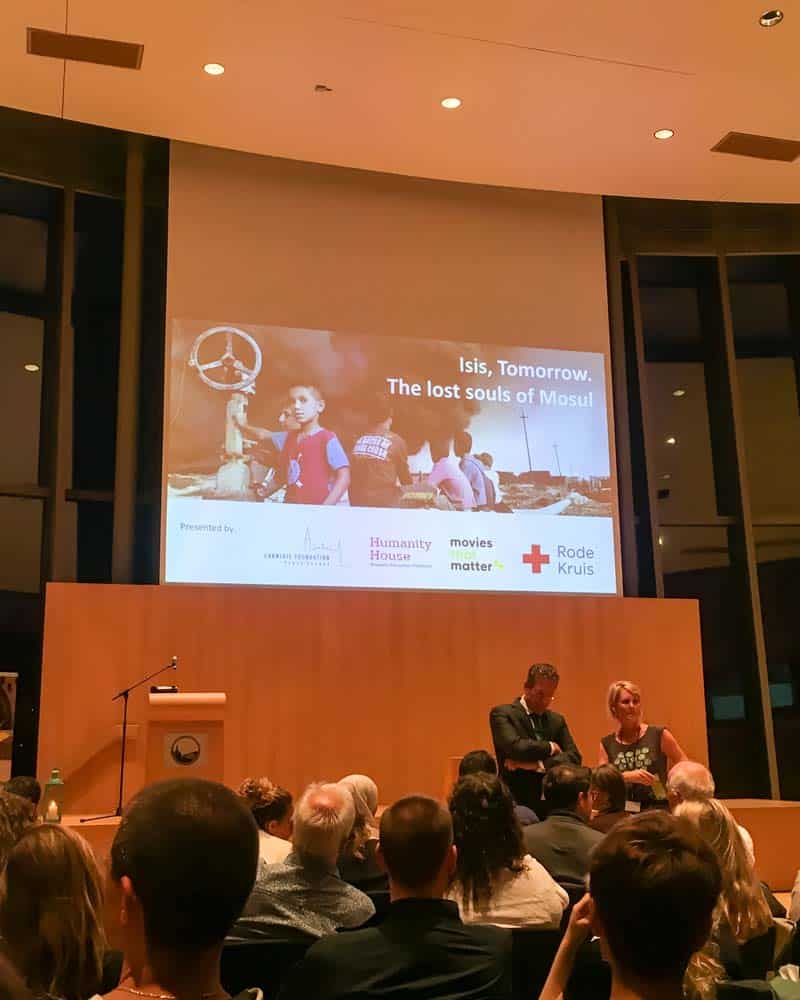An eye-opening visit to The Hague during the Peace and Justice weekend
This website uses affiliate links which may earn a commission at no additional cost to you. As an Amazon Associate I earn from qualifying purchases.
Updated: 30th October 2019
‘This is Mother Earth to all of us, and we all need to find a way to share it with each other, even if we don’t like each other. Tolerance isn’t tolerating something you do like; it’s tolerating something you don’t.’
On a residential street, away from the buzz of The Hague’s city centre, Muawi Shehadeh shared the story behind his restaurant, Love & Peas. Drum-rolling jazz plays lightly in the background as I scoop another delicious dollop of hummus onto warm and slightly crisp pita bread. Around us, an eclectic crowd of students to OAPs from all ethnicities relax on second-hand renovated chairs laid out like a cosy living room.
‘The idea is food brings people together, the political things are still there, but we all need to eat, it’s a basic human need. We can share a plate and share a future, ’ Muawi continues as he shows me newspaper clippings of his business partner Tubal Gal. But why was this restaurant such big international news? Muawi hails from Palestine, and Tubal is from Tel Aviv.
A Polish waitress, Lidia, fluent in Mandarin, clears the array of mezze plates while recommending a dessert from the entirely vegetarian menu. There is no sign announcing the vegetarian experience, though; Muawi didn’t want any labels on the door; he wanted an inclusive space, and he wanted to bring real hummus to The Hague.
My first evening meal in The Hague set the scene for the weekend that would follow. A city of diverse stories, international residents, and, as a bonus, incredible food. Known as the city of Peace and Justice, for many globally, The Hague is more of a symbol than a place, two words thrown around when discussing political crimes. But for the half a million residents who come from near and far, The Hague is home. For countless others affected and touched by the international decisions made here, it’s a place of hope, truth, and, most importantly, justice.
Every September, for one weekend, in celebration of the United Nations International Day of Peace, The Hague opens its most important institutions to the public, providing the perfect chance to learn, understand, and discover this already fantastic city in a whole new light.

How did The Hague become the centre of peace and justice?
While Amsterdam is the capital of The Netherlands and the most famous and visited city, The Hague is home to the country’s Parliament, courts and the working city of the Dutch Royal Family.
It was in 1899 that The Hague progressed to be an international city of peace when a peace conference was hosted between the big states. Here, treaties were sanctioned to define the laws of war, and in particular, war crimes. Although the International Court of Justice came later and is still far from perfect, it was in 1899 that the Permanent Court of Arbitration was founded. In 1913, The Peace Palace officially opened its doors, followed by many more institutions, such as the Former Yugoslavia Criminal Tribunal.
The Hague has always been an international city due to invasion, changing hands and migration, and with The Netherlands remaining neutral in some of history’s most defining wars, some would say it naturally fell into its position as the city of peace and justice. In 1945, on the founding of the United Nations, the International Court of Justice found its home here, followed by countless other institutions such as Europol and the International Criminal Court.
The foremost goal of The Hague’s leading institutions was to prevent war through the word of law; thus, it became known as the city of peace and justice.


What is the UN International Day of Peace and The Hague peace weekend?
A designated Peace Day devoted to the strengthening of the ideals of peace between people and nations, The United Nations General Assembly established the day in 1981.
For The Hague, the weekend surrounding this is naturally the ideal time to celebrate its place in the world of peace and justice, and many events mark the poignant day throughout the city. From beach-side fundraisers for charities to the doors being flung open at some of the most esteemed international courts, the weekend programme in The Hague allows visitors the chance to see precisely where these high-level cases and discussions have taken place.
Of course, access to these institutions isn’t just restricted to the weekend, with some of the courts holding limited public viewing seats year-round. But with this very much being a working city and courts in action, the chances to tour and visit many of these places are far more restricted outside of these dates.

Visiting The Hague during the Peace and Justice weekend
When planning my trip to The Hague alongside the tourism board, I think it’s fair to say I wasn’t sure what to expect. While there are a few canals, the occasional tulip shop and plenty of locally brewed beers, The Hague is undoubtedly very different from what most visitors to The Netherlands imagine, which is surely the postcard-perfect image of Amsterdam.
Would I be able to fill a long-weekend in The Hague I pondered, and it was those concerns and my personal fascination in law, peace, and justice, which led me to settle on visiting during the Peace Weekend programme. It turns out, though, that The Hague is actually a fantastic city-break destination regardless of whether any events are going on, and I’d go as far as saying it’s the perfect European city break.
If you are planning a visit here any other time of year, see my reasons to visit The Hague post to understand why I loved it so much and just how varied a destination it is.
But if you’re as interested in the Peace and Justice side of the city as I am, here is everything you can do to get under the skin of this side of The Hague, with many of these attractions being year-round, not just open during this special weekend.


Start your visit at Museon
The final stop on my Hague weekend trip should be your first. Museon might be a museum for children, but its bitesize approach is easy to understand. Combining natural history and learning experiences, it’s a popular spot for school groups.
In fact, my mind was blown by the education school children receive in The Netherlands outside the classroom. From touring Parliament and international courts to the ProDemos group, which teaches the children of the nation about democracy and law, these are lessons I feel every country should adopt for their education system.
But the reason I suggest making Museon your first port of call in The Hague is the simple approach taken in explaining complex subjects, which lays the perfect base understanding for everything else you’ll learn here. From immigration to justice administration, the expositions during my visit spelled out the facts, figures, and purpose of these institutions in the most understandable of ways, providing an ideal introduction to the city of peace and justice.

Delve into the history and purpose of the Peace Palace
Stepping into the imposing entrance hall of The Peace Palace, I was immediately humbled by the grandeur, but more so the very purpose of this building and the conversations and trials that have taken place here. After a vigorous security check on arrival for the tour, you pass into the gardens of this international symbol of peace and justice.
Inside this impressive and slightly out of place architectural wonder sits the Permanent Court of Arbitration, and the United Nations International Court of Justice, different to the International Criminal Court housed elsewhere in The Hague.
Walking through the hallways, shaped by different corners of the globe, the international decoration is striking. Marble from Italy, art from Hungary, vases from Russia and carpets from Japan are just some of the many gifts that are housed in the Peace Palace. Decorated by donations from countless countries, the actual construction and building of the Peace Palace was funded by Andrew Carnegie, who was born into a working-class Scottish family but went on to become one of the wealthiest men in the world. To this day, the foundation in his name still administers the Peace Palace, as he wanted his wealth to mean something more.
The various chambers and public courtrooms are all breathtaking in their own way, whether from the individual coats of arms stitched into the chairs or the court cases that have played out here. Our guide took time to explain the purpose of each chamber and court while highlighting some of the most famous cases and gamer-changers who had been represented here. Behind the Peace Palace, in a modern building, hundreds of students from around the world learn about International Law at the acclaimed Hague Academy of International Law.
If you visit The Hague, honestly don’t miss the chance to tour The Peace Palace – guided tours are limited throughout the year as court is often in session, but planning your visit around a public opening is well worth it.


Discover politics and royalty at the Inner Court & The Hall of Knights
‘We don’t have a changing of the guard, because, well there is no guard’ my guide Stefan joked as we stood a few feet from the Kings working Palace, protected by a simple fence. Behind us, underneath a huge chestnut tree, a group of people sat at tables enjoying an outside movie.
Politics and royalty in The Netherlands didn’t seem as removed from the public as in other countries. The Prime Minister still often cycles to work, and recently, it was revealed that the King himself had been piloting commercial KLM flights part-time. With over twenty different political parties and the requirement that at least two parties are in the Cabinet at any one time, it was starting to become clear to me how such a pro-democracy city had found itself as the de facto home of peace and justice.
Perfectly reflected in the still lake that sits infant of Parliament, the Prime Minister’s office sits small amongst the grand architecture of the building. To the rear of this pretty-as-a-postcard image, a magnificent gate marks the entrance to the Inner Court.
The Inner Court, known as Binnenhof, is open to the public around the clock, continuing the shared sense of politics within The City. Within the complex sits the Senate, and it’s proud of being the oldest parliament building in the world that is very much still in use.
Walking through the courtyard, you can quickly forget the purpose of the buildings around you; students sit eating lunch on benches while dog walkers and joggers pass by me. In the middle of the courtyard stands arguably The Hague’s most impressive building, The Hall of Knights.
Every year, the King arrives on a horse-drawn carriage in quite the spectacle to deliver the government’s plans for the year. Inside the Hall of Knights is the Throne Room, where the King does this reading, and it can be visited by a tour throughout much of the year.

An emotional interactive experience at Humanity House
‘Experience what it’s like to be a refugee’ is how the Humanity House Museum, funded by the Red Cross, is billed. Of course, that’s more of an interest stirrer than a fact, as it’s an experience I’ll (hopefully) never know nor understand. The interactive museum, however, is still very much a must-visit in The Hague, giving a little insight into the reality many tragically face.
In August last year at Edinburgh Festivals, I watched a play called How Not to Drown – the writer and the lead actor, Dritan, stood on stage and shared his true story as a child refugee from Kosovo. Packed onto a boat as a teen from Albania, his family waved him off in hopes of a better life.
What struck me the most about his story and Humanity House was how little of the overall picture the journey is. In the Western media, we are often struck by the treacherous travel, often by over-capacity boats that refugees take, but the coverage stops once dry land is reached. The never-ending reallocation of foster parents, the eternal journey to gain a passport, the reality of never speaking to your loved ones again; the truth is that while the immediate danger might be over when you reach a new land, safety and security are still far from achieved.
On entering Humanity House, you are issued with your Red Cross ID, as if you don’t have a passport, this becomes your only reference as a human being. In a hallway with rows upon rows of folders, you can place your registration letter; perhaps, if you are lucky, the Red Cross can use this to locate and reconnect you with your family eventually.
‘What would you do if you had a passport?’ was one of the questions that struck me most after completing the interactive part of the museum and arriving at a selection of stories told by refugees that now call The Hague home.
“Stay calm for the rest of my life, and my children will be safe. That’s a hard question; I’ve never had a passport all my life,” was an answer by Aham, a Palestinian who sought refuge in Syria before eventually coming to The Netherlands. As a Palestinian, a non-state not recognised by the UN, Aham can’t have a passport, so he can’t have a Dutch passport, and he can’t ever be a citizen. He has temporary residency – but what happens if that ends? It’s a life I could never imagine.


There are countless stories told in Humanity House, from Bosnian war refugees to LGBTQ rights issues in Jamaica. Some of these hit closer to home for me, as I’ve sat and shared stories and tea with people on my travels who have recounted these moments of their lives firsthand.
In the relaxed cafe above the museum, where cyclists and trams glide past the windows, I chatted with one of the Humanity House team members about the project. We talked about why I moved to Portugal, and I briefly mentioned Berlin had been on my radar, but I had concerns about not being able to get dual citizenship after Brexit.
I realised what I had just said out loud in this setting: my privilege allowed me to worry about having two citizenships, while the stories downstairs often had none.
Over lunch, a somewhat sombre occasion set against the trendy Bleyenberg rooftop cafe, I look out on the skyline of The Hague and ask myself the question: ‘What would I do without a passport’ – it’s a question that would haunt me, and my privilege, throughout the weekend.

Delve into war bunkers and history at the Oranjehotel
A mere 15-minute bike ride from the city you’ll pass unassuming sand dunes, important for both historical and future reasons. It’s these dunes that protect The Hague; without them, the city could quickly be underwater, but they also hide a reminder of WWII.
The Netherlands remained neutral in the First World War, a small country with limited resources at the time. In World War Two, they defended themselves as best they could, but within a week of the invasion, they had been forced to surrender, and the waterfront of The Netherlands quickly became a prime stronghold for the Nazis.
The seaside town of Scheveningen was evacuated, leaving it to become a Nazi military base of tunnels and caves, a far cry from the cocktail-serving chic beach bars that now live here.
Throughout these dunes, there are military posts, and at the Widerstandsnest 318 Bunker, you can venture inside to learn more about the occupation and the WWII history of The Hague.
Perhaps the most educational and yet harrowing of ways to understand The Hague’s importance in WWII is to visit the recently re-opened National Monument, Oranjehotel.
This intense and emotional museum is housed in the original blocks where prisoners, often the resistance, would wait to either be sent to concentration camps, forced into labour or, for a few, eventually liberated. In different cells, you can watch video stories of survivors who once were imprisoned in these rooms, and in some, the etchings of prisoners’ words remain on the wall.
As a museum, it’s highly informative, and I had to fight back the tears at some points. Another part of the old prison barracks has now been transformed into an initial base for refugees arriving in The Hague.
Through the wide windows, you can see across to the still in use part of the prison, which also holds prisoners on trial at the nearby International Criminal Court.


Understand at the International Criminal Court (ICC)
As part of the International Weekend of Peace and Justice, the International Criminal Court also hosts an open day where you can learn more about what happens in these courts and the institution as a whole.
If you visit outside the weekend, you can still come to the ICC Visitor Centre to understand its role. Also, a public viewing space is sometimes open for a limited number of people to see the cases as they unfold live in court.
Unlike the Peace Palace, the ICC focuses on a very particular group of crimes which aren’t between states but include war crimes and genocide. Many view the ICC as flawed as its jurisdiction only stretches to the countries that have signed up for the treaties, and major players such as China, the United States, and Russia are noticeably absent from this. Nevertheless, it’s an important international institution, and the opportunity to learn how it works will allow you to make your own decisions on its effectiveness.
For the people that the ICC represents, though, their compelling testimonies and the courts’ results underline just how important it is for many, and maybe one day, it will indeed be a global court where everyone can fall under the same laws of prosecution.

Festival vibes on The Hague beach at War Child Peace Sessions Festival
One of the things I loved about The Hague so much is just how diverse its offerings are, from trendy bars to intense interactive museums and even a golden stretch of coastline. Needing some reflection time after an emotional morning, I jumped on my bicycle, sped through the sand dunes, and arrived at the beach for a drink.
Being the Peace Weekend, events had stretched beyond the city centre and spilled out onto the beach. An event for War Child, a charity founded in the UK and now with a Dutch arm that supports children affected by war, was hosting a fundraiser and festival in the late summer sun.
With rows and rows of bars and restaurants along the beach, this was certainly the side of The Hague that surprised me most, and it’s well worth taking the short tram ride or bike route out to.


Join in the fundraising at the Peace Night Run
Following a feast of Indonesian cuisine, which is a staple in The Netherlands due to the large Indonesian population and colonial past, I stepped out to watch the start of the Peace Night Run.
A charity fundraising event which happens every year in The Hague, the route takes eight kilometres around the city, passing monuments such as The Peace Palace, where rows of candles had been laid outside. Neon clothes, torches and glowsticks illuminate the way, and if you find yourself in The Hague during the peace weekend, it’s a fun way to get more involved and raise funds for a good cause.

Visit the “world’s happiest war memorial” at Madurodam
On the final day of my long weekend in The Hague, after a breakfast where plain-dressed men with earpieces were casually around due to a high profile hotel guest, I headed to a miniature Netherlands-land, a park some may argue is for kids.
Madurodam, however, isn’t just a place where perfectly crafted miniature Dutch buildings live. Being The Hague, there was, of course, a peace and justice reason behind it, and it is often referred to as the ‘happiest war memorial in the world’.
George Maduro is one of The Netherlands’ war heroes who died in WWII following his defensive attack after the invasion of The Netherlands. George was tragically captured in 1943 and died a year later in the Dachau concentration camp.
His parents then donated the funds to start Maudurodam to remember their son, and the park now raises money for charity projects itself.
It’s also a fascinating place to walk around and take inspiration for where else to visit in The Netherlands. In a country where Amsterdam often steals all the attention, I was really pleased to discover other smaller cities through their tiny models, and it has grown my list of places I’d like to visit throughout the country.

A final moment with Movies That Matter
The rain thundered down as I cycled across the city towards the Peace Palace for my second visit of the weekend. This time, it was for a movie in the garden, although the showers inevitably meant it was moved inside.
Co-hosted by Movies that Matter, the film choice I heard was always a debated topic amongst the various organisers of the event. This year, the final selection was ‘Isis Tomorrow: The Lost Children of Mosul‘ – certainly not light viewing.
The student seminar hall of the Peace Palace, where people from around the world study international law, was the rainy-day alternative for the screening, and in rows of chairs sat a mixed crowd quickly subdued by the documentary-style film in front of us. It was a harrowing yet fascinating watch and a movie I highly recommended to see the ongoing reality. Whatever film is shown in years to come for this event, though, I can’t think of a more impactful location to witness this kind of movie.
It’s not often, or ever in fact, that I’ve ended a city break watching a documentary on ISIS in the back hall of one of the world’s most important institutions. This wasn’t an average city break, though; it was a weekend that, over time, I’d realise had impacted me far more than ticking off the typical Amsterdam must-do list.
The weekend had been full of eye-opening and thought-provoking moments that would amplify in the weeks following my visit. The magnitude of the rooms I’d been in, where the global figures of our world have written modern-day history started to hit me fully. The stories I’d heard from those whose journeys ended in The Hague becoming their home echoed in my mind. The tears I shed reading the etchings on a prison wall kept coming back. And, while these aren’t the insta-moments travel is being rebranded as, they are the crucial moments we need to remember, to learn from, and most importantly, realise for many aren’t the past and ‘never again’ but, they are the present and the bleak future.
In need of wine and some time to process, I cycled back to the leafy square where my weekend had started, damp autumn-coloured leaves clinging to the pavement. Passing Parliament, a small light illuminates the prime minister’s office.
I’m reminded there is hope for peace and justice, but the fight to keep democracy alive, and accessible to all, is one we can never give up on.
Need to Know: The Hague
A few tips and details to help you plan your visit to The Hague.
Important Dates in The Hague for 2020
May sees the Invictus Games come to The Hague, and on the 4th and 5th of May, Remembrance Day is honoured with various events followed by the Liberation Festival, a massive celebration that brings thousands to the city.
September marks the 75-year celebration for the UN and The Hague as the city of peace and justice. The Peace Night Run will be on the UN International Day of Peace, Monday 21 September 2020, so expect the Peace Weekend events to be the weekend prior TBC.
What else to do in The Hague?
Check out my long weekend guide to The Hague to find out about all the other great things to do in The Hague, not just those related to the city of peace and justice.
Getting to The Hague
The Hague can be quickly reached by train from Amsterdam airport in around 30 minutes by car or train and is well connected to most cities in The Netherlands by train. Rotterdam-The Hague shared airport is even closed, although cheap flight options are more restrictive.
Where to stay in The Hague
During my visit to The Hague, I was hosted in the Staybridge, ideally located looking out on Parliament. This brand new hotel was converted from the Norwegian Embassy and offers a real home away from home vibe with social evenings three times a week. An all-suite hotel, the rooms provide comfy bedding and bathrooms, and an additional room with a lounge area and kitchen, which given that many visitors to the city may be staying for extended working periods figures. It was a perfect hotel, ideally located, and offered a great breakfast and bike hire.
If you are visiting The Hague on a budget, there are hostel options, too, including the highly-rated Pink Flamingo Hostel and The Student Hotel.
If you want to go all out, then book into the Hotel Des Indies, a truly royal and grand hotel in the city centre that has a long and distinguished history in the making of the city, and has welcomed celebrities and royalty for years – even if you don’t stay here, it’s worth popping in for coffee like I did.
Alternatively, if you want to base yourself by the beach in The Hague rather than the city centre, consider staying in a fully-decked out beach hut which looks super cool, or the famous, grand and yet reviews say slightly dated, five-star Kurhaus of Scheveningen hotel.




There are lot of places to explore in Holland. Madurodam is one of the best place to visit.
It’s a fantastic place!
I did my short tour in October but could not explore the land as you did. Will definitely explore it next time.
Very good information. A very nice place to hang out,
Beautiful destination. You inspire me to think outside of the regular tropical vacation spots.
Glad to hear :)